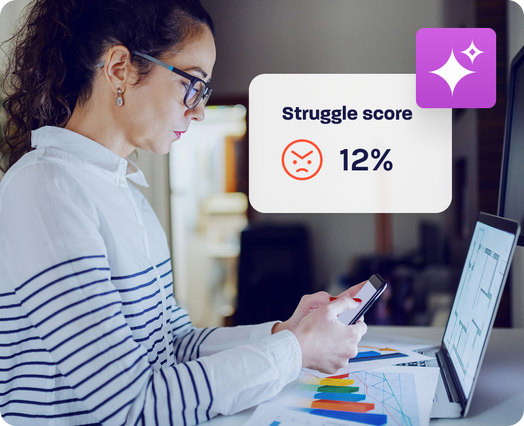
Using digital experience analytics to improve customer engagement
How customer analytics allows businesses to monitor and resolve customer struggles and optimize digital journeys.
2020 was the year when digital really took off. The pandemic accelerated the shift from physical to online, and organizations embraced new channels and technology to engage with customers and prospects. This makes digital experience analytics even more important as businesses look to make sense of all the new data generated by digital activities and find ways to optimize the digital experience (DX.)

Adobe reports that 63% of B2C organizations saw an unusual growth in digital customers due to the pandemic. This mirrors other research, showing that 62% of US consumers shop online more now than before the pandemic. A 2021 report from Retail Economics and Natwest has found that, since the pandemic began, nearly half (46%) of UK consumers have purchased a product online that they had previously only ever purchased in store.
This digital growth gives marketers more choice in how they communicate with customers—and likewise customers have greater freedom to navigate their preferred digital journey. Businesses have greater ability to optimize the channel that delivers the best experiences for customers—and the best results for the business.
Working out what these channels should be is the latest challenge. Accessing and analyzing the huge spike in data to calculate the approach that will deliver optimal results is reliant on digital experience analytics.
The case for using analytics to improve customer engagement
Customer engagement encompasses a lot of channels, the most important being digital channels. Digital experience analytics is an automated process that captures unstructured information generated by user clicks, page views, scrolls and taps (to name but a few interactions) and converts it into structured data ready for analysis.
This solves the first major problem for the business. It’s impossible to manually structure and analyze the huge amount of behavioral data that customers create. Automating this process makes data analytics faster and easier, which means the business can uncover actionable insights at speed. There is no reliance on data scientists or IT specialists to run reports or get the data into the right format before analysis can begin.
On a relatively superficial level, the business can now see how customers have engaged with messages or products. Marketing can see which campaigns drove highest engagement; customer service can see which web and app struggles are producing the highest number of calls; and product owners can see which features are most popular.
The real benefit lies in taking digital analytics to the next level. This gives analysts a full picture of a customer’s end-to-end digital journey, showing how engagement led to a conversion or another desired outcome. An action at one part of the digital journey can be linked to a subsequent action at a later point.
This is arguably of greater value to the organization. It removes “vanity metrics” and allows the business to focus on what really matters, highlighting the effect that one action had on the overall journey.
Through customer analytics, the business can compare an enormous number of digital journeys and extract insights that show what combination of events and actions deliver the best customer experiences (and, of course, the best outcomes for the business.)
What is a customer engagement score?
Organizations calculate a customer engagement score to measure how engaged their customers and prospects are. Each customer’s score is calculated depending on:
- How they’ve responded to your attempts at engagement
- How they are using your products and services
A high score denotes an engaged customer, someone who is likely to make a purchase soon or recommend you to others. A low score signifies that the customer is not opening emails or messages and is not engaging online or on mobile, and therefore is highly unlikely to convert any time soon.
As with digital experience analytics, customer engagement scores can be used at a higher level to show how different audience segments are engaging to your various activities. For example, you may quickly identify that a particular segment’s average customer engagement score has suddenly dropped, indicating that churn is likely. You can use these insights to target at-risk customers and incentivize them to remain loyal.
Customer engagement scores are also a great tool for measuring the effectiveness of your sales funnel. Once a prospect hits a predetermined threshold, sales can see that a conversion is a high probability and act to close the deal. In this sense, customer engagement scores are a good metric for marketing to demonstrate the revenue that can be attributed to their activities.
Struggle scores can play a big role in determining a customer’s engagement score. A struggle score calculates the effects of technical issues (such as slow page loads or dead links) and user behavioral issues (such as rage clicks) on DX. A high struggle score could go a long way to explaining a low engagement score, helping the business to understand why a customer is disinterested and how to get them more engaged.

Real-time engagement, real-time analytics
Speed is one of the pillars of digital transformation. Understanding what’s happening and why at the precise moment it’s taking place offers a great opportunity to improve the customer experience. With the tools to monitor customer engagement in real time, struggles can be observed and resolved when in matters.
Real-time digital experience analytics makes this possible. Using artificial intelligence (AI), automated alerts can be triggered when certain behaviors or events take place. This means the business can take speedy action to recover the customer before they abandon the transaction.
The need to request analytics reports from IT specialists or wait for the availability of data scientists is a common cause of delay in customer analytics. Every delay in accessing insights reduces their potential effectiveness. With real-time analytics businesses can act immediately to optimize every digital experience.

Using customer experience analytics to plan for long-term success
We’ve talked about using digital analytics to deliver immediate improvements to the customer journey. Analytics also increases the chances of long-term success for businesses.
Not everything is a quick fix. Improving the digital customer experience also involves analyzing trends and journeys over time to capture common patterns and understand how engagement is evolving. Armed with in-depth knowledge about customer activity, businesses can modify journeys to better reflect what customers want and expect.
This goes beyond a pop-up message or triggered cart abandonment email. Long-term analytics looks at why these events happened in the first place and allows organizations to build digital experiences that prevent them from happening as frequently. Rather than using analytics to fix a customer struggle, the aim is to prevent it happening at all.
Continuous improvements to optimize the digital experience
Ultimately, digital experience analytics empower the business to improve the digital experience. With access to behavioral insights, delivered as they happen in a structured and easily accessible format, businesses can take the necessary steps to continuously improve digital journeys.
Short-term struggles can be dealt with as they happen, while long-term strategies can be plotted based on how customers are engaging. In this way organizations can create happier customers who are more likely to engage more often, spend more and recommend you to their family and friends.
Are your digital experience analytics driving success or holding you back? Take our digital customer experience analytics maturity assessment to find out.








